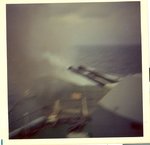parsifal
Colonel
US radar was so clear it could observe the fall of shot. The turret azimuth and bearing was controlled from the director, and this in turn obtained its data from radar fixes.
Radar assisted fire control, from 1943 onward was vastly superior to optical fire control, even in clear weather. Fall of shot was often not observed accurately under visual conditions, and the stereoscopic system in use at the time had the same difficulties as the low definition radars
A Naval War College study performed during World War II estimated that an Iowa Class (BB-61) battleship firing with top spot against a target the size of the German battleship Bismarck would be expected to achieve the following hit percentages (when using the Mk 34 Director) .
Range Percentage hits against a broadside target Percentage hits against an end-on target Ratio
10,000 yards (9,144 m) 32.7 22.3 1.47:1
20,000 yards (18,288 m) 10.5 4.1 2.56:1
30,000 yards (27,432 m) 2.7 1.4 1.92:1
An image of the Mk 34 director with mk 13 radar is attached
Sdmittedly this is a study for the 16" gun, but it does show just how good the USN FC systems had become by wars end
If these estimates were accurate, these ships were dangerously accurate in their fire which has to be attributed to radar direction in the Fire control arrangements. nothing else can explain its accuracy in my opinion. During Java Sea, for example there was something like 1200 rounds fired (from memory, at ranges of about 20000 yards. Only a handful of these rounds hit anything
Radar assisted fire control, from 1943 onward was vastly superior to optical fire control, even in clear weather. Fall of shot was often not observed accurately under visual conditions, and the stereoscopic system in use at the time had the same difficulties as the low definition radars
A Naval War College study performed during World War II estimated that an Iowa Class (BB-61) battleship firing with top spot against a target the size of the German battleship Bismarck would be expected to achieve the following hit percentages (when using the Mk 34 Director) .
Range Percentage hits against a broadside target Percentage hits against an end-on target Ratio
10,000 yards (9,144 m) 32.7 22.3 1.47:1
20,000 yards (18,288 m) 10.5 4.1 2.56:1
30,000 yards (27,432 m) 2.7 1.4 1.92:1
An image of the Mk 34 director with mk 13 radar is attached
Sdmittedly this is a study for the 16" gun, but it does show just how good the USN FC systems had become by wars end
If these estimates were accurate, these ships were dangerously accurate in their fire which has to be attributed to radar direction in the Fire control arrangements. nothing else can explain its accuracy in my opinion. During Java Sea, for example there was something like 1200 rounds fired (from memory, at ranges of about 20000 yards. Only a handful of these rounds hit anything
Attachments
Last edited:



